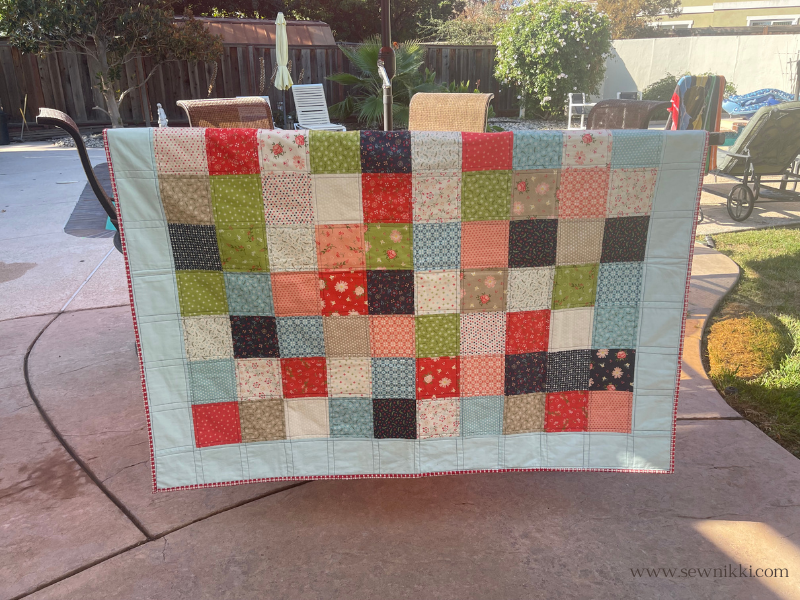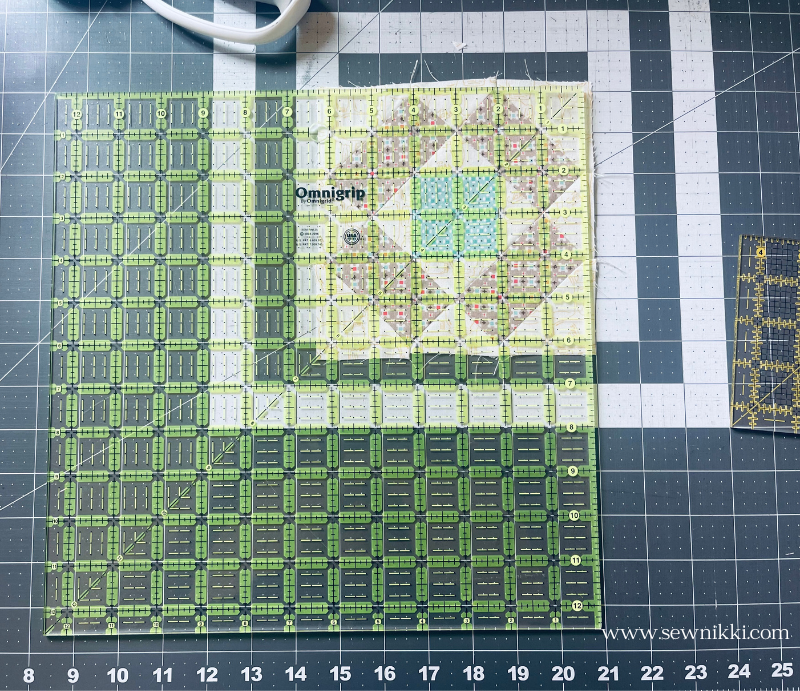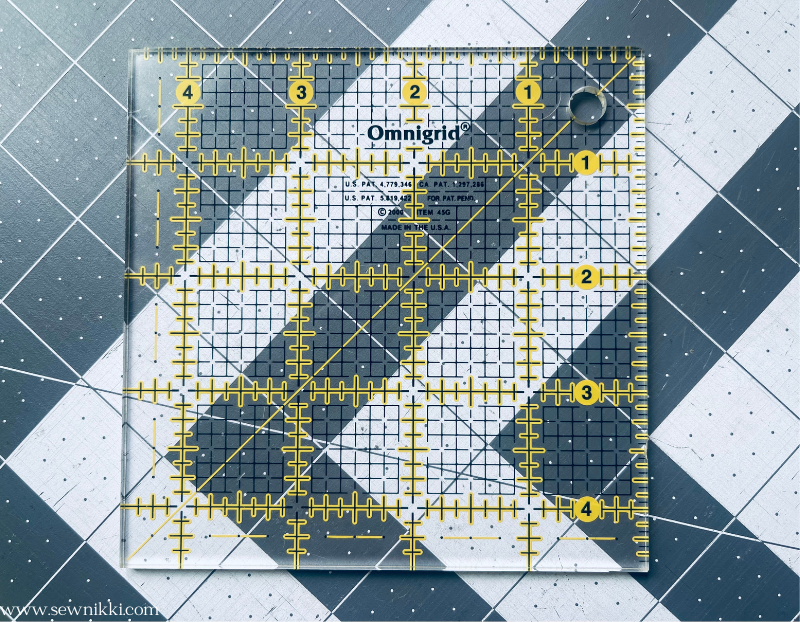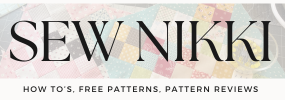Quilting tips for beginners. Here are 10 super helpful quilting tips for beginners. Some of these I just learned this weekend and wanted to share with you. If you are new to sewing and quilting, I’m here to cheer you on and share some things I am learning on my quilting adventure with you.
I have been quilting for a little over three years now and still feel like a beginner even though I have made lots of quilts, pillows, zippered computer case, zippered bags, table runners, desk top runners, table toppers and quilted potholders. Every table in my house has a quilted item covering it. I’m focusing now on making quilted items for wall décor in my new office at work but back to the list of helpful quilting tips for beginners.
My Sewing Journey
This craft was very overwhelming at first. I was so very green, didn’t know anything about sewing let alone quilting. Owned absolutely nothing that you need to sew. Wasn’t really sure what I needed to get started but grabbed the beginner supplies I “felt” were necessary to get me started.
I slowly learned how many gadgets and supplies were needed and it wasn’t cheap. My memory thinks I spent about $100 and that didn’t include the sewing machine. My eyes were so wide open every time I entered the craft stores. Mesmerized by all the different sewing machines not knowing what I actually needed. Looking at the sticker prices and thinking I may be a little crazy. Adding the prices in my head and also wondering how much this was gonna cost.
Maybe I was going through a mid-life crisis, I really didn’t know. I had too much time on my hands and nothing to do. My family was in another part of the state and I was left to my own devices. I crocheted of course but wanted to learn another craft and those quilts looked amazing. I wanted one, wanted to use the cutter and rulers, sewing pins and get to play on a sewing machine. Here are helpful tips I want to share to help you in your quilting journey.
Make sure you check this out!
After you read this post, make sure you also check out How To Learn How To Quilt: Beginner Quilting Guide. It’s jam packed with even more information, links and resources that are so helpful when you’re first learning. It also has a section with free quilt patterns that are great for beginners. So make sure you check this out, seriously don’t forget!
Grab the Learn to Quilt for Absolute Beginner’s Guide, filled with helpful information to make your first quilt. Click the link below for the free download.
10 Quilting Tips for Beginners
1. Straight Line Quilting
Before you start a project, take into account what you can do. Can you quilt the blocks or pattern? This may sound like a strange thing to think about but it’s really important. You need to be able to quilt it properly and not all patterns are good for simple straight line quilting.

If you are a beginner and you machine quilt on a domestic sewing machine you can only really quilt straight lines with a walking foot. Straight line quilting is when you follow the seam lines in your quilt block. Starting at the top of the quilt and quilting all the way to the bottom. Repeating this process until you quilt both vertically and horizontally.
2. Best Beginner Quilts

The best beginner quilt is a charm square quilt made with 5″ squares. You want to pick a pattern that you can actually quilt so get a 5″ charm square pre cut pack. There is something like 42 squares that come in these packs. It will be a small quilt but you are just beginning and need to start somewhere. This is where you should begin. This will be very small quilt but make it. I must have made 5 or 6 of these charm square quilts and I focused on sewing the blocks together with straight lines and having the correct 1/4″ seam allowance.
3. Quilting Tips for Beginners – Nesting Seams
Charm square beginner quilts have a simple pattern. You lay out the 5″ blocks in the charm pack and create rows. Then stack up your rows and take it to the sewing machine and connect with 1/4″ seam. Repeat for all rows then connect the rows together. Use sewing pins where each seam connects and pin it there. The flaps of fabric need to go the opposite direction when you sew over it. Use your fingers to nest the seams.
Lining up seams is very important. This is something you need to master. You can feel when the two fabric seams are nested. Wiggle the two rows at the seams, with the fabric for the rows going in opposite directions to nest. You don’t want the fabric at the seams to go the same direction because it will create a bump and will be hard to quilt.
4. Best Beginner Quilt Blocks
Almost all quilt patterns use quilt blocks that are sewn together with a border added around the outside of them. Some quilts also use sashing in between the quilt blocks and sometimes cornerstones. Quilt blocks can be small or large. The most common sizes are 6″ for small quilt blocks and 12″ or 12.5″for large quilt blocks. There are smaller sizes and larger sizes of both but these are the most common.
The best beginner quilt blocks are large quilt blocks that are 12″ or 12.5″ finished. They are the best for two reasons. First, you can straight line stitch and there’s a lot of room in the block so it won’t look a mess. When you make smaller quilt blocks, like 6″ or 6.5″ finished blocks then straight line stitching is more compact. It makes your quilt tighter and I think it’s best to use these smaller blocks in a table runner, table top or small wall hanging.
Second, the most common square quilting ruler is the 12.5″ square ruler. Because you will have this quilting ruler in your arsenal, you know you can make this block because you have the correct ruler to trim it up. Trimming up quilt blocks is important so that all the blocks are the same size when you connect them together.
5. Quilting Tips for Beginners – Make Sure You Quilt Correctly
Quilting with you walking foot with straight lines as a beginner is challenging. You should not rush when you are quilting. Your machine will go a little slower with the walking foot because it’s making sure the fabric on the top of your quilt and the backing fabric are moving under the presser foot together. It’s feeding the fabric under the sewing needle so they move as one unit.
Make sure you are doing the correct amount of quilting. Quilting secures the fabrics and batting together. The type of batting you use will determine the area you need to quilt. Some battings can have 4″ between quilting lines, other battings can go up to 6″, you need to figure out what your batting requirements are for quilting. If you don’t have enough quilting on your blanket or throw, then over time the fabric can rip more easily and become damaged from use because you didn’t stitch it down enough. You left too much fabric without any quilting to secure it.
For example, if you have a 12″ quilt block and only quilt on both sides of the square, this is not enough quilting. You need to have quilting in the middle and possibly going both vertically and horizontally.
Knowing what block patterns you can actually quilt is one of the biggest steps in picking a pattern. Experienced quilters should know how to free motion quilt. Free motion quilting can be done on any pattern or block because you are free to quilt anywhere and not restricted to following seam lines in the block. I have loved many a pattern but when I looked at how I could straight line quilt it, or not quilt it, then it effected which patterns I could actually do as a beginner.
6. Must Have 5″ x 24″ Straight Line Quilting Ruler
You also need to take into account what rulers you have. Rulers are such a big part of quilting and they aren’t cheap either. Beginners should start with a 5″ straight line quilting ruler.

My friend Gail bought me my first quilting ruler, it was a 6″ straight line quilting ruler. I still have it but most quilt blocks call for 5″ squares so the 5″ ruler is the quickest. She was so sweet, all my girlfriends from my life group were cheering me on in my sewing and quilting adventure. They thought it was very cool that I wanted to learn how quilt given the fact that I didn’t even know how to sew! I just had the itch to quilt, working with fabric and turning it into beautiful quilts looked like so much fun. It was and is fun but there’s so much that I’m still learning.
7. Another Must Have 12.5″ Square Block Quilting Ruler
One of the things I’m still learning is why 12″ or 12.5″ quilt blocks are so popular. There are a ton of quilt encyclopedia books in the craft stores that feature thousands of different blocks.

I finally figured out this weekend that this size is popular because the 12.5″ square quilting ruler is the second ruler you need to buy for quilting supplies. You will use this ruler for all the blocks in these quilt pattern books and for log cabin blocks.
8. Yet Another Must Have 4.5″ Square Block Quilting Ruler
One other ruler that I have is the 4.5″ square quilting ruler. This one is a must when doing half square triangles with the standard 5″ charm square.

Again, the 5″ charm squares are the most common size used for making half-square triangles. The finish size of this unit will be 4.5″ so this 4.5″ square quilting ruler is a must have for beginner quilters. Once you master the basic charm square quilt, you will move onto half square triangles and you will be frustrated if you don’t have the proper ruler for squaring these block up.
9. Quilting Tips for Beginners – Sewing Machine
Let’s be real, you can’t do anything until you have a sewing machine. The sewing machine is the most important item to sewing and quilting.
Know what you can do on your sewing machine. My other girlfriend Jeannie loaned me her “very old” but free sewing machine. If you are just starting out and testing the waters to see if you even like to sew or quilt then borrowing a friend or family members machine is smart. There are a ton of sewing machines that you can buy and if you don’t know anything about this craft, it can be brain overload.
If you don’t have any friends or family members that sew and are “willing” to loan you their machine then I suggest this machine. The Singer heavy duty sewing machine which you can get for about $200.00. This craft is not cheap. I actually machine quilted my first king size half square triangle quilt on a singer heavy duty and entered it into the local fair.
The throat on the Singer isn’t very large but it was large enough to make it work. It’s a work horse and you can even get the model with the extension table which I highly recommend. I notice that most people that sew clothing don’t use the extension table but I can’t quilt without it. It provides a larger work surface when you are sewing your quilt top.
10. General Tips On Buying Quilting Rulers
There are so many different brands to chose from. Look at them closely and make sure they have diagonal grid lines and are easy for you to read and understand. I just made a table topper with 6.25″ blocks. I was piecing together units that were 3.5″ and under. I grabbed my 4.5″ square ruler but it was really hard to read the 2.5″ lines. There is tape that you can put on your ruler to mark out the exact dimensions you need but I didn’t have any tape. Also didn’t want to go try to find the tape or spend any more money on supplies.

Ended up using my 12.5″ square block quilting ruler. I have two of these rulers because I was gifted one. One ruler has neon green and is easier to read when my block is under it and it has diagonal lines for trimming up 2.5″ half square triangles.
I also had to trim hour glass units. These are two half square triangles placed on top of each other and sewn again to form two smaller half square triangles. This time I needed to find the middle of a 2.5″ unit with my 12.5″ square block ruler. I had to find the 1.25″ marking both vertically and horizontally with the diagonal line hitting the half square correctly and trim. This was hard at first but a great option than having to buy another ruler.
Best Quilting Supplies for Beginners
Here are some quilting tools and supplies I recommend. I make a small commission if you purchase through the links, this helps to support this free content. For more info, check out Supplies for Beginners (Best Tools To Start).
Rotary Mat Cutting Mat (Self-Healing Mat)
28 mm Rotary Cutter Replacement Blades
45 mm Rotary Cutter with Sharp Blade (start with this one)
45 mm Rotary Cutter Replacement Blades (start with this one)
60 mm Rotary Cutter Replacement Blades
4.5″ Square Ruler for half square triangles
12.5″ Square Ruler for blocks
Sewing Machine Beginner (see my about me page for more info on sewing machines for beginners to the one I use today).
This post contains affiliate links, which means I make a small commission at no extra cost to you. See my full disclosure here.
SEW NIKKI FREE RESOURCES
FREE PATTERNS
Flying Geese Throw Quilt – Flight
Pinwheel Table Topper Pattern – Jolly
Log Cabin Scrappy On Point Quilt
Chevron Placemat Quilt Pattern
Strip Quilt Block Pattern – Roundabout Quilt
TUTORIALS
How to Sew a Handbag with Recycled Jeans
Make Heat Proof Recycled Denim Potholders
Learn How to Quilt Beginners Guide
How Long Does it Take to Make a Quilt for Beginners
Learn to Sew – Conquering Your Fears as a Beginner
How to Quilt on a Regular Sewing Machine
How to Sew Binding on a Quilt – Quilting Tutorial
Best Fabric for Quilting: How to Shop Like a Pro!
How to Make Half Square Triangles – Easy Formula Chart
How to Baste a Quilt: Beginner Spray Basting Tutorial
10 Essential Quilting Tips for Beginners
How to Sew a Pillowcase With Flap in 15 Minutes
How to Sew Quilt Squares Together | Quilting Tutorial
Joining Quilt Binding Ends for Beginners
How to Cut Fabric for Quilting- Easy and Accurate
How Wide to Cut Quilt Binding & Make Easy Strips
Pieced Quilt Backing Ideas – Super Simple Backs
How to Make Quilt with Sashing and Cornerstones
Quilting Supplies for Beginners – Best Tools to Start
How to Machine Quilt with Walking Foot
Heat Proof Recycled Denim Potholders
How to Bind a Quilt – Easy Single Fold Binding
About Sew Nikki
If this is your first time stopping by, welcome! My name is Nikki. I’m a weekend quilter, have a super small sewing space and taught myself how to sew and quilt by watching YouTube videos! My blog has How-To’s, Free Patterns and Pattern Reviews. Read more about me here.
Follow me on social media (Pinterest, Instagram, Facebook and Twitter) so you get notifications when I post new patterns and tutorials.
Want to learn how to crochet? Then check out this post, How to Learn How to Crochet – Guide for Beginners.
Sew, quilt, crochet and repeat!

So much thought went into explaining these tips, Nikki! Thanks for spelling it all out so that those of us who are beginners can move forward with smart purchases.